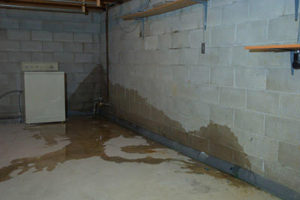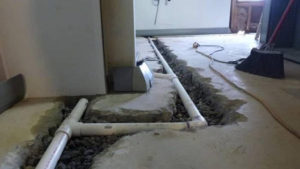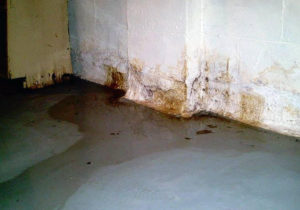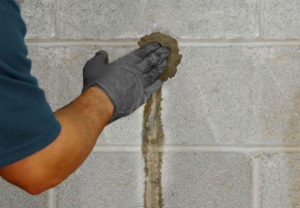Wet Basements and Crawlspaces: A Primer
It is not uncommon to hear from homeowners that they have a musty smell, dampness and evidence of water damage that are all signs of a wet basement or crawlspace. About 65% of all houses suffer from some form of basement or crawlspace wetness. Block foundations are especially vulnerable, with an 80-90% chance of seepage within 20 years of their construction. Even in houses without basements or crawlspaces, excessive moisture can adversely affect the ground level floors and even upper floors and attics.
It Can Happen to Anyone!
You should start with the assumption that all spaces below grade such as crawlspaces and basements are vulnerable to water intrusion at any time. A house with water problems doesn’t necessarily mean it was poorly constructed. Water can appear in even the most well-built homes.
The Signs of Water Problems
A few signs of water problems to look for, other than the obvious pooling water sitting on the ground include:
- Rust at the base of heating or plumbing fixtures
- Stains, discoloration, or decay on wood posts, paneling, walls, or sheetrock walls
- Damaged floor tiles or carpet
- Apparent mold/mildew on walls or surfaces of storage objects
- Efflorescence on foundation walls
- Rotting wood
- Water stains on the bottoms of storage items such as furniture and boxes
- Cracked or bulging foundation walls or floors
- Insects
- Musty odors
- Damaged, leaking plumbing fixtures

Direct Leakage: Water may flow through obvious openings, through unnoticed cracks or through the intersection where the floor meets the wall. Poor ground surface drainage outside the house is the most frequent cause of this kind of water penetration. Occasionally, water supply pipes and pipes in crawlspaces, which are in poor condition may cause leakage. High water tables or underground aquifers are sometimes responsible.
Seepage: Water can seep through the same pathways as mentioned above but at a slower rate. Some moisture seepage occurs directly through moist foundation walls and floors, especially in warm weather.
Condensation: Since warm air can hold more water than cool air, condensation is caused when warm, moist air moves into a cooler air space or comes in contact with a cooler object. For example, when warm interior air comes in contact with a cold surface such as metal window frames or a cold water piper, the water vapor in the air turns to liquid and collects on the colder surface.

If you’ve been putting off addressing your basement or crawlspace problem because you are afraid it will be too expensive or too complex to fix, you should know that simple remedies may offer relief from the problem. Once you learn all you can about water control, you can deal with routine maintenance and care that may make the difference between a damp and dry living space.

1. Pitch the adjacent ground away from the house at a slope of approximately ½” to 1” per linear foot.
2. Gutters and downspouts (leaders) are important for diverting water away from foundation walls. Gutters should be cleaned and should be sloped properly down toward the downspouts. Test the underground downspouts to make sure they are not clogged or leaking toward the foundation. Put a hose down there and find the termination point, and make sure water if flowing to the final point. If the downspouts are above ground, they should extend several feet away from the house to a lower point and discharge into a splash block.
3. Stop water entry through basement windows by maintaining window wells that are at least 4” above a positive grade away from the house. Clean the window wells periodically. Plastic domes can often help keep the wells clean and free of leaves and water.
4. Remove sunken flower beds close to the foundation walls as they may retain too much water.
5. If you have basement stairwells, make sure there is a storm drain at the bottom that is kept clean and free of leaves. It also should be properly sized and designed by an architect or engineer.
6. Adjust automatic sprinkler times to reduce the amount of watering. Sprinklers near the house should be checked to ensure that water is not being sprayed against the foundation.
7. Be sure that patios, driveways and walkways slope away from the foundation. Seal cracks between foundation walls and these surfaces with caulk.
8. Trim vegetation at least one foot away from the house so the house can breathe. Remove any ivy from the exterior as well.
Interior:
1. Seal any foundation wall cracks with caulk or epoxy.
2. If the crawlspace floor is only dirt, you should install a vapor barrier. It can range from a product called “Clean Space” to sprayed in concrete to a 6 ml. polyethylene sheet that laps up onto the walls.
3. Prevent sweating or dripping from condensation by wrapping cold water pipes, well tanks and air conditioning ducts with insulation. Also, have a licensed plumber inspect your plumbing for any signs of immanent leaks and check the age and condition of your water heater to prevent leaking.
4. Use a dehumidifier that is properly sized for the given space from spring through autumn. The humidity level should never be allowed to exceed 50% and should be monitored with a separate hygrometer.
5. If there are bathrooms or laundry rooms, all vents should go to the outside.
Waterproofing:


